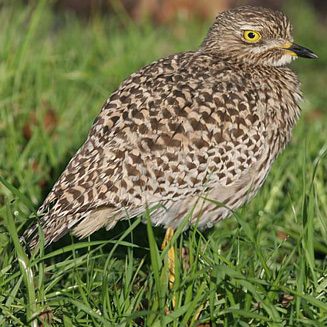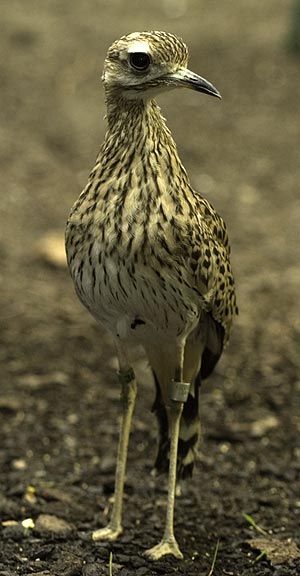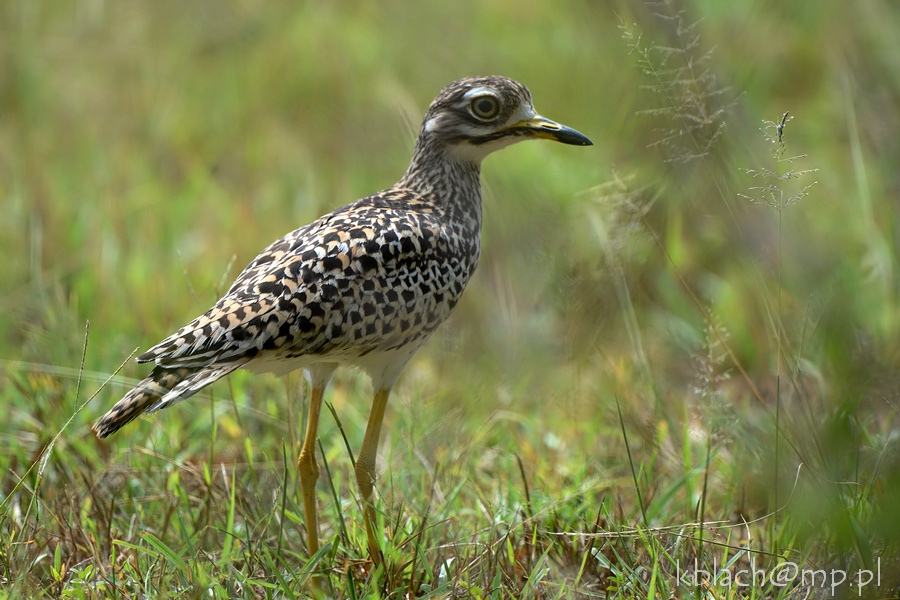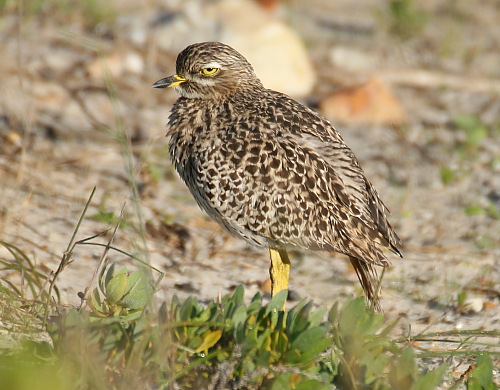
Burhinus capensis
TAXONOMY
Oedicnemus capensis Lichtenstein, 1823, Cape of Good Hope.
Four subspecies.
OTHER COMMON NAMES
English: Spotted thick-knee, Cape dikkop, Cape thick-knee;
French: Oedicnиme bistriй; German: Dominikanertriel; Spanish:
Alcaravбn Venezolano.
PHYSICAL
CHARACTERISTICS
16–17.5 in (37–44
cm) Most obviously
spotted thick-knee,
rich rusty-brown
with bold black arrow-
head spots,
whiter below with
fine streaks and
white on the face,
behind the eye, and
on the throat. The
bill base, eyes, and
legs are rich yellow.
This is an elongated
species, long-winged
and long-tailed.
DISTRIBUTION
Found in a narrow sub-Saharan band from Senegal on the west
coast to the Horn of Africa in the east, with a small, isolated
population in Arabia; extends south, more widely and commonly,
through East Africa to Zambia and in a broad zone
across the south of the continent. The
DISTRIBUTION
reflects unsuitable
areas of the Sahara in the north and the Congo basin
forests in West Africa.
HABITAT
Semi-arid areas away from marshes and rivers, but sometimes
more or less wooded in dry savannas or around clumps of trees
and bushes near open grasslands; such cover is important in
providing daytime shade and shelter. Sometimes found on
playing fields, parkland, and near coastal beaches.
BEHAVIOR
Seeks shade and cover by day; pairs or small groups remain
quiet and still until dusk except on dull, cloudy days when they
may feed.
FEEDING ECOLOGY AND DIET
Typical plover-like feeding action involves a steady forward
walk and a swiveling, tilting motion to pick up food from the
ground in the bill. Large insects are favored, but a number of
crustaceans and frogs are eaten, as well as a limited amount of
vegetable matter, mainly seeds. It feeds mostly at night and entirely
on the ground.
REPRODUCTIVE BIOLOGY
Pairs are monogamous, probably established for several seasons,
breeding in the dry season or at the beginning of seasonal
rains. The nest is a simple hollow made on bare ground
with the feet, sparsely lined with small pebbles, grass, leaves,
and dried animal droppings. Lays two eggs (less often one or
three) and incubation lasts 24 days; chicks fly at eight weeks.
CONSERVATION STATUS
Its ability to cope with human activity and limited alteration of
open habitats allows the spotted dikkop to thrive in quite wellpopulated
areas, so long as disturbance and persecution remain
slight and housing or industrial development is absent. Generally
quite numerous in suitable areas, one of the more common
and most secure thick-knees.
SIGNIFICANCE TO HUMANS
Most African people take little or no specific notice of the
spotted dikkop in areas where nocturnal noise from an assortment
of birds and mammals is common.
Photo Gallery of - Spotted dikkop




 Animalia Life
Animalia Life